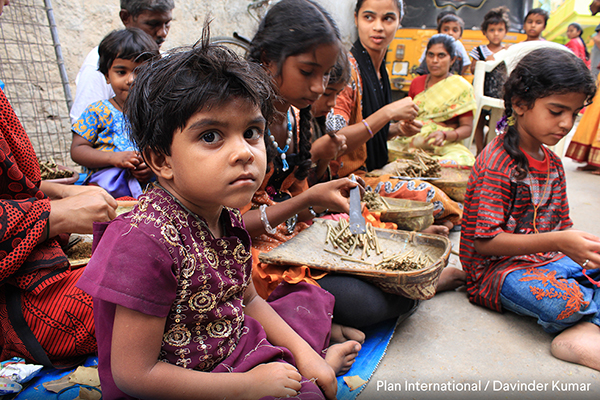By Akiva Singer
Throughout the world, around 168 million children are involved in some sort of child labour. To help raise awareness and achieve its goal of eliminating child labour by 2025, Monday, June 12 is the ILO’s 16th annual World Day Against Child Labour. Child labour of all kinds poses serious threats to the health of the children involved, and in no case is this more true than that of child tobacco farming.

Child bidi cigarette rollers in India. Photo: Plan International / Davinder Kumar
The widespread use of child labour in the farming of tobacco in countries such as Indonesia pose unique health threats to those children involved. Most prevalent of the health effects are acute nicotine poisoning, vomiting, fatigue, and stomach pain brought about by the absorption of nicotine through the skin of workers handling tobacco leafs. Acute nicotine poisoning is essentially unavoidable for anyone who works harvesting tobacco, including children.
While the long-term effects of nicotine absorption through skin are yet to be studied, similar studies on smoking suggest that nicotine exposure in childhood has serious implications on brain development as well impairing the development of memory, impulse control and decision making.
While Indonesia does have measures in place to prevent such types of child labour, they have proved to be largely ineffective. Indonesia is aligned with international labour standards and prohibits children under the age of 18 from working in hazardous environments, including those involving “harmful chemical substances”. However, tobacco itself is not expressly prohibited or specified as being a “harmful chemical substance,” so children can legally work in tobacco fields and be exposed to nicotine and harmful pesticides. Even if the law was clearer in its language, child labour laws are not well enforced in Indonesia, and the specified law could only go so far in eliminating child tobacco labour.
Perhaps a larger obstacle than ineffective law is the economics that sustain child labour. As stated by the ILO “poverty is the main cause of child labour in agriculture.” Most of the tobacco farms in Indonesia are small and family owned. The money saved by using their children instead of hiring another worker has a huge impact on a family’s income. Add onto this a culture in which family farming is the norm, and rural poverty rates double those in the urban areas.
Big tobacco companies rely on small, family farms for much of their tobacco production, particularly in Indonesia. In most cases, they do not buy directly from farmers, but instead from warehouses and traders removed from the original farming process. This allows tobacco companies to reap the benefits of cheap child labour without having to take direct responsibility for it.
Although there are obstacles to eliminating child tobacco labour in Indonesia, it is a problem that can be solved. Like Indonesia, Brazil, relies mostly on small family farms for its tobacco production and has less than a fraction of Indonesia’s issues with child labour. It has achieved this by creating and enforcing strict child labour laws specific to tobacco, that have real and severe punishments for both farmers and corporations benefitting from child labour.
On this World Day Against Child Labour we should remember, while child labour is strongly interwoven into the supply chain of the tobacco industry in many countries, it is a problem that can solved through effective and clear changes in policy and law enforcement.